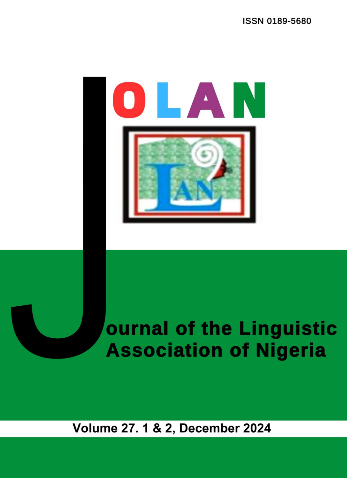Ète Ìṣewe ̣́kú nínú Ìwé-Ìtàn Àròsọ Ó le kú
Keywords:
Ìṣewe ḳ́ ú, ìgékúrú, ìsopo, ìto kas ̣́ í, ète ìṣewe ḳ́ ú, Cohesion, ellipsis, conjunction, reference, cohesive devicesAbstract
Yoruba
Ìṣewékú jẹ́ìbáṣepọ́tó ń farahàn ní ìpele seṃ́ áńtíìkì nígbà tí a bá ń ṣafo, ̣́ èyí tí ó máa ń so àwọnfonṛ́ áninú gbólóhùn pọ́lati di odidi. Àfojúsùn pépà yìí ni láti ṣàgbéyeẉ́ ò bí àgbékalẹ́ìṣeweḳ́ ú nínú Halliday and Hasan (1976) (pàápàá ète ìṣeweḳ́ ú) ṣe wú lò fún ìtumo, ̣́òyeàti ìṣokan ̣́ àwọn fonṛ́ án ìhun nínú àwọn ìwé ìtàn àròsọ Yorùbá nípa lílo Ó le kú ti Akínwùmí Ìṣọlá kọ gẹgẹbi ìtọkasí. Àwọn gbólóhùninú ìwé ìtàn-àròsọ yìí ni a lò fún déétà-fáyeẉ́ ò wa. A fa déétà-fáyeẉ́ ò wonỵ́ í jáde nípa kíka ìwé ìtànàròsọ náà ní oṕ̣ oḷ́ọpọ́ìgbà lati ṣàkíyèsí onírúurú ète ìṣeweḳ́ ú tí òǹkoẉ́ é ṣàmúlò nínú ìwé náà àti ipaàwọn ète wonỵ́ í lórí ìtumọ́ìwé náà. Nínú pépà yìí, a wo ìtokas ̣́ í, ìgékúrú àti ìsopọ́geǵ̣ ẹ́bí ète ìṣeweḳ́ ú. Àwọn ète ìṣeweḳ́ ú tí a ṣàfihàn wọn yìí máa ń mú kí àkójọpọ́gbólóhùn nínú iṣe-̣́ọnà aláwòmọlítíréṣọ́ ní ìṣeweḳ́ ú tí kò fi ní dàbí pé won k ̣́ àn ń jẹyọ bí ó ti wù wọ́ Àbájáde ìwádìí yìí fihàn pé òǹkoẉ́ é loète ìgékúrú àti ìtokas ̣́ í láti dín àwítúnwí kù nínú ìtàn náà, èyí mú kí gbogbo àwọn gbólóhùn inú ìwénáà ṣe weḳ́ ú. Àwọn oṛ́o-̣́àsopọ́ni òǹkoẉ́ é lò láti so oṛ́o, ̣́ àpólà, awẹ́gbólóhùn àti odidi gbólóhùn pọ́áti fún ìtàn náà ní àrògún àti ìtumo. ̣́ Àbájáde iṣẹ́yìí fi Akínwùmí Ìṣoḷ́á hàn geǵ̣ ẹ́bí ẹni tó ní ìmo-̣́oṇ́ -ṣe ìmédèlò nítorí pé ó lo oríṣìíríṣìí sítáì láti gbé kókó inú ìwé ìtàn àròsọ Ó le kú jáde sí àwọn òǹkàwé.
Abstract
Cohesion is a relation that occurs on the semantic level of communication which links sentential elements together into a unified whole. There are several cohesive relations that link the sentences into a text. The essence of this study is to examine the extent to which Halliday and Hasan (1976) model of cohesion (precisely cohesive devices) is used to achieve unity, meaning, understanding and readability in Yoruba literary texts, using Ó le kú as a case-study. Ó le kú is a prose text written by Akinwumi Isola, a renowned Yoruba literary artist. The data for the study consisted of Yoruba sentences selected from the novel. The data was extracted from the novel by reading through the text severally to note the different types of cohesive devices used by the author and their effect on the interpretation of the text. The paper investigates the extent to which the author of Ó le kú uses the textual resources of cohesion and cohesive devices to link ideas in the sentences used in the text and examines the effect that the cohesive devices used have on the quality of message passed across in the novel. In this paper, we deal with reference, ellipsis and conjunction. These mechanisms of cohesion, common to all languages, make a series of sentences coherent, so they do not seem to occur randomly. The purpose of ellipsis and reference is to avoid the burdening repetitions within the text, and to make the whole text cohere. Coordinating conjunctions were used as joining or linking devices in the text. The author based on the outcome of the study used intermixed styles to convey his message to the readers.
References
Eggins, S. 2004. Introduction to Systemic Functional Linguistics (2nd Edition). London, UK: Continuum
Fontaine, L. 2013. Analysing English Grammar: A Systemic-Functional Introduction. New York: Cambride University Press
Halliday, M. A. K. and Matthiessen, C. M. 2014. An Introduction to Functional Grammar. New York: Routledge
Halliday, M.A.K. and Hassan, P 1976. Cohesion in English. London: Longman.
Ìṣo ḷ́á, A. 1974. Ó le kú. Ìbàdàn: Oxford University Press Limited.
Kafes, H. 2012. Lexical cohesion: an issue only in the foreign language? English Language Teaching, 5, III, pg. 83-94.
Nunan, D. 1993. Introducing Discourse Analysis. London: Penguin English.
Osisanwo, W. 2005. Introduction to Discourse Analysis and pragmatics. Lagos: Femulus Fetop Publishers.
Paltridge, B. 2000. Making Sense of Discourse analysis. Gold Coast, Queensland: Antipodean Educational Enterprises.
Peterson, C., & McCabe, A. (Eds.). 1991. Developing narrative structure. Hillsdale, NJ: Lawrence Erlbaum Associates.
Van Djik, A T. 1992. Text and Context Explorations in the Semanticss and Pragmatics of Discourse. London: Longman.














